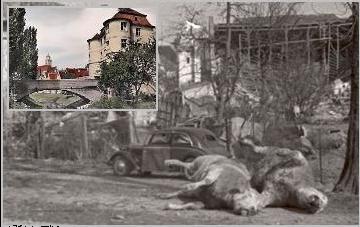Marburg was bombed, but fortunately suffered relatively minor civilian damage.
Targets: SchoolsA terrible fate befell the settlement in 1943 and 1944 when Allied bombing killed 1,000 civilians and destroyed 3,000 houses, almost totally destroying the town. In March, 1945 there was one last attack on Meerbeck in which 70 people leaving a bomb shelter were machine gunned by a low flying plane.
The air raid alarm went off here 437 times in the last 16 months of war. The first major attack on the city was on the outskirts on March 18, 1944 with two more attacks on the city itself on July 20, 1944 and April 9, 1945 which levelled almost the entire southern part of town. A third major attack on the city took place immediately before the war ended on April 20, 1945, even though it was known the German air base in Memmingerberg was no longer operable. Bombing destroyed over 30% of residential buildings, many antique buildings. 630 people lost their lives. After the Americans arrived there was looting. Image: in the 1300s and in 1945.

|

|
From 1943 to 1945, Minden was bombed. On December 29, 1943 British high-explosives bombs and aerial mines destroyed a good part of the older upper section of town and damaged 420 buildings in the city center. 29 people were killed. In October 1944, 250 American bombers attacked Minden, killing 73 people, 25 firefighters among them. In November, 1944, 305 high-explosive bombs were again dropped on populated areas killing another 115 people, 103 of them inside an air raid shelter, and injuring 50 more.
Attacks in December, 1944 took another 41 victims and left 820 families homeless.The December attack severely damaged the ancient cathedral. Minden faced daily alarms from the beginning of 1945. At this time, 1,000 civilians a day were dying from air attacks in Germany. On the late morning of March 28, 1945, bombers dropped lethal loads on the ancient Minden cathedral and surviving parts of the historic city center. 186 more people died. Six days later, the town was occupied anyway.
Allied bombings here killed about 558 Russian prisoners in a work camp here and about 200 other workers. Atop of 150 civilian bombing victims, one fifth of the soldiers drafted from Moers were killed or missing in war. Almost all of the 3,000 houses were damaged and 1,000 completely destroyed.

The fact that people just walking and farmers doing their chores seemed to be intentionally struck down from the air gave way to some panic and even increasing bitterness of the victims. On March 19, scenic Mühldorf am Inn in Bavaria was hit, killing 130 civilians and their farm animals, above

The first purposeful attack on Muelheim was minor, and took place on May 13, 1942. By the end of the war, 1,305 civilians in Muelheim died from Allied bombs, with the strongest attack killing 530 on June 23, 1943. 557 British bombers attacked Muelheim city center and industrial areas to the north in three waves, destroying 64% of the city center. Mosquitos, in low-altitude flight, disengaged the fire protection and police channels. This was an unwarned attack.Marking of the city center first by the “pathfinders” was a well rehearsed, accurate art by now, so that bombs of the first wave fell concentrated into the range of the targeted city center.
The Rathaus, both hospitals, and the ancient churches of Petri and Marienkirche burned completely. 530 civilians were killed, 1,630 buildings were totally destroyed, and the firemen had to struggle with 150 major fires, 700 medium fires and 2,250 small fires. 40,000 humans were suddenly shelterless with no gas, water or electricity.
On Christmas Eve, 1944, 338 British bombers in a combined attacked struck the airfields at Muelheim with 200 airplanes and 760 tons of bombs, but killed 250 people in an air raid shelter. The USAAF attacked the battered city center on March 21, 1945, killing another 22 people.
